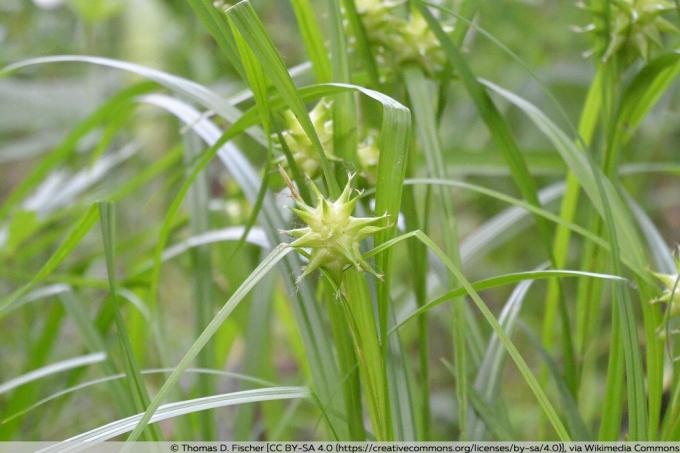
table of contents
- Characteristics
- Location
- floor
- plants
- Plant out in the open
- Bucket culture
- care
- to water
- Fertilize
- Cut
- Overwinter
- Multiply
- Diseases and pests
Profile and care information open +conclude -
- Flower color
- yellow, inconspicuous, green, brown
- Location
- Partial shade, sunny
- Heyday
- June, July, August, September
- Growth habit
- upright, bushy, clump-forming
- height
- up to 80 cm high
- Soil type
- loamy
- Soil moisture
- moderately moist, very moist, fresh, wet
- PH value
- neutral, slightly acidic
- Limescale tolerance
- Calcium intolerant
- humus
- rich in humus
- Poisonous
- no
- Plant families
- Sourgrass family, Cyperaceae
- Plant species
- Ornamental grasses
- Garden style
- Natural garden, forest garden, water garden
The morning star sedge is a robust plant. But this is not the only quality that makes the plant easy to care for. Because the Morgenstern sedge is also extremely flexible and adaptable in terms of soil and location. However, one small “disadvantage” has to be mentioned: it grows more slowly compared to other sedges. Incidentally, the name “Morgenstern” goes back to the appearance of the fruit.
Characteristics
- botanical name: Carex grayi
- Genus: Carex
- Plant family: Cyperaceae (sour grass family)
- Habit: upright, 40 to 80 centimeters high, 25 to 30 centimeters wide
- Flower: yellowish green, later brown; spike-shaped, inconspicuous, resemble small balls
- Flowering period: June / July to August / September
- Leaves: simple, light to bright green, lanceolate, narrow, entire, sharp-edged, 20 to 30 centimeters long
- Fruit: brown nuts with a prickly surface with a high ornamental value
- non-toxic
- Origin: Eastern Canada, Northeast USA
Location
The Morgenstern sedge grows in open spaces and at the water's edge, which is why it is often used to green the garden pond. But it can also be planted in beds, borders and swamp or rock gardens. A sunny to partially shaded location is ideal for the plant. It should also thrive in the shade, but it seldom forms the decorative fruits in shady locations.
floor
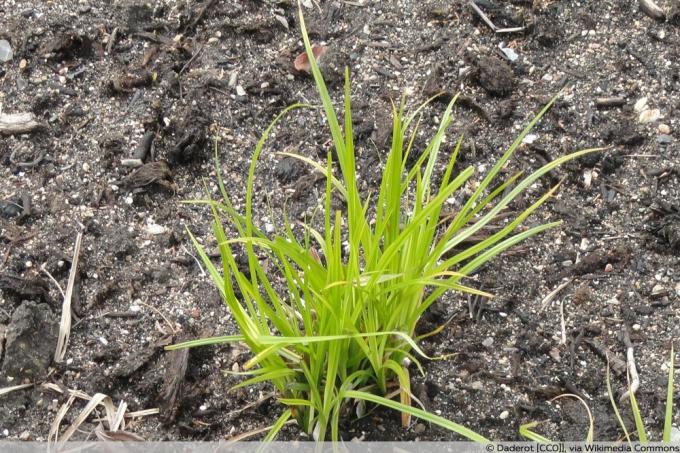
As a plant that can be planted on the bank of a pond, the Morgenstern sedge tolerates damp to wet soils. However, it does not tolerate flooding of the site. Furthermore, the plant prefers
- loamy soils
- a pH of 5.7 to 7.2
- permeable
- fresh
- a topsoil thickness of at least 20 centimeters
However, it can also cope with normal garden soil. Carex grayi does not tolerate salty soils. Your tolerance to lime is classified as medium to sensitive. Morgenstern sedges have no problem with oxygen-poor soils.
The following substrate has proven itself for the bucket culture:
- Mix of potting soil and peat or humus
- permeable
- wet
- Plant neighbors
In the field or on the bank of water, Carex grayi gets along with all plants that have the same demands on soil, location and care. Attractive combinations result, for example, with clump-forming bamboo, lamp cleaner grass or Chinese reed.
plants
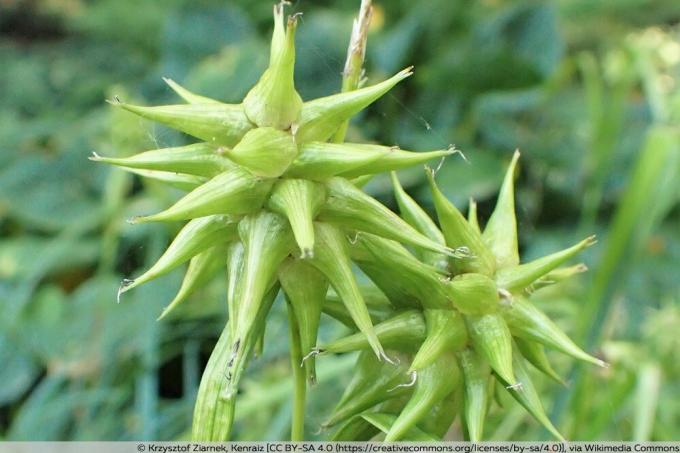
Morgenstern sedges can be planted in a group or as a solitary plant. However, they are best shown in groups of three to five specimens. The following guidelines apply to planting in groups:
- Plant spacing: 30 to 35 centimeters
- corresponds roughly to: 7 to 9 or 10 to 12 plants per square meter
Plant out in the open
The ideal time to plant the sedge is in spring. Before you plant the plant outdoors, regardless of location, you should rid it of weeds. Then follow the instructions below:
Dig the planting hole
- Size: twice the size of the plant's root ball
- possibly. Create a drainage layer
- possibly. put well-rotted leaf compost into the planting hole (nutrient supply)
- Water the morning star sedge before planting
- Place the root ball in a bucket with lukewarm water
- Lift out after about ten to twenty minutes
- Let excess water drain off
- Place the sedge in the planting hole
- Planting depth: as before in the pot, never deeper
- Fill the planting hole with garden soil
- Lightly press
- water well
Bucket culture
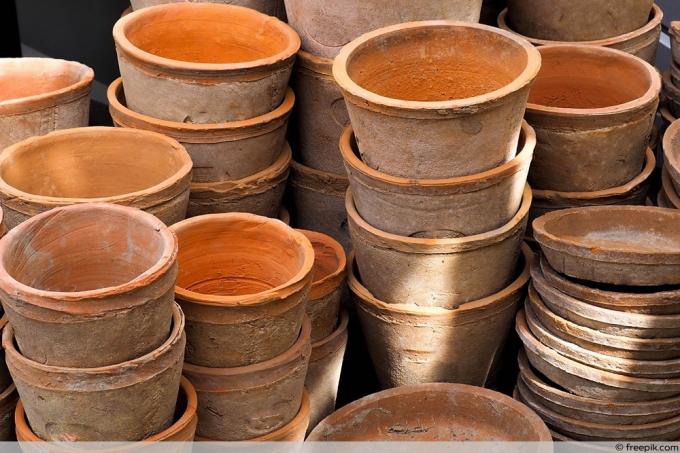
Only plant pots with at least one drainage hole should be used for potting, so that excess irrigation or rainwater can drain away. The size of the planter should be about twice the size of the root ball. It is important that the distance to the edge of the bucket is about two to three centimeters. This gives the roots enough space to grow. When planting, follow the instructions below:
- Water Carex grayi (see instructions for planting out in the open)
- Lay a drainage layer of gravel and / or potsherds at the bottom of the planter (absolutely necessary)
- put a thin layer of substrate on top
- Place the sedge in the planter
- Planting depth as in the pot before
- fill up with substrate
- Lightly press
- water lightly (already watered plant)
care
Morgenstern sedges are extremely easy to care for, robust and adaptable plants. Their main growing season is in spring and summer. If they are in the right place, they hardly need any maintenance. Only in the container culture do the plants need regular water and fertilizer applications, since in this case the plants cannot take care of themselves.
Tip: Remove weeds very carefully so as not to damage the delicate roots of Carex grayi.
to water
The Morgenstern sedge shows only a low tolerance towards dry soils. That is why it needs additional watering outdoors during dry periods. In the bucket culture, you should always keep the substrate moist. However, the plants cannot tolerate waterlogging. Carey grayi manages without additional watering on swampy water edges. The ideal time for watering is in the early morning and evening hours, i.e. before or after exposure to the sun.
Tip: With morning star sedges that are planted out, you should ensure that there is an adequate water supply, especially in the first year of planting.
Fertilize
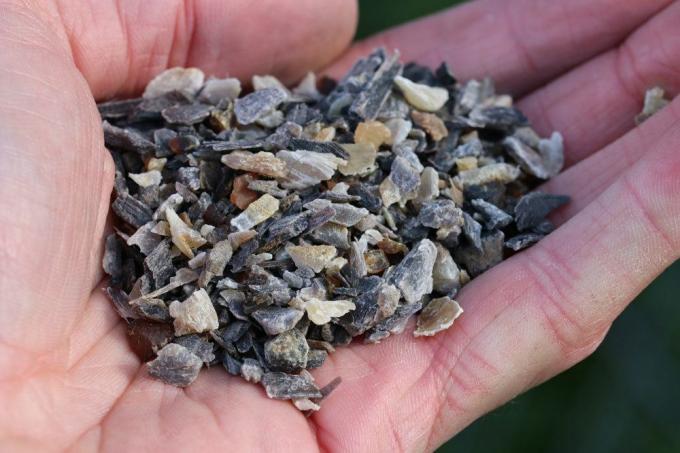
Whether the Morgenstern sedge needs fertilization depends on the location and the type of cultivation. On natural pond edges, streams or natural wood edges, it usually does not need any fertilizer. On the other hand, it is happy to receive additional nutrients at other locations and in the bucket culture. In the bucket culture, fertilize the sedge every two to four weeks. The rule here is: less is more. In other locations in the garden, fertilize the plant in spring with a normal garden fertilizer or spread horn shavings over the soil.
Cut
Before you start pruning, protect your hands and arms from the sharp-edged leaves of the morning star sedge. A knife, hedge trimmer or secateurs are suitable tools. It is important that the cutting tool is sharp and clean. This is how a smooth cut is achieved. In addition, the risk of disease transmission through the tool is reduced.
Tip: If the pruning tool was previously used to prune diseased plants, then you should Disinfect before cutting, even if the tool has not been used for several weeks or months was.
Cut back
Since the plant draws nutrients from leaves and fruits over the winter, pruning does not take place until the following spring.
- Time: February to March
- on a frost-free day
When pruning, all dead leaves of the sedge are shortened to 5 centimeters above the ground. To do this, you do not have to cut leaves individually, you can also cut them off in bundles. It is important that you do not cut off any green parts of the plant.
Thin out
You can clear completely dried up leaves from spring to autumn, especially if the pruning fails. You should not thin out in winter, as the dried up leaves are a protection for the plant. As a rule, you do not need a cutting tool for thinning out, because you can simply pull out the individual sheets by hand. Don't forget to protect your hands with gardening gloves.
Overwinter

When planted out, Carex grayi can withstand temperatures down to minus approx. 18 degrees Celsius (= winter hardiness zone, USDA zone, 7). In winters with little snow or Regions as well as in the case of clear frost, you should still protect the plants. For this purpose, a layer of leaves and / or covering the ground with (fir) brushwood is recommended.
Bucket culture: winter protection and care
In the bucket culture, the morning star sedge does not tolerate cold and frost so well. This is because the cold easily penetrates through the bottom and walls of the planter and the roots freeze to death. Therefore, you need to pack the bucket as follows:
- Cover walls with cold protection for plants
- Place the plant on a thick wooden board or a styrofoam plate against the cold "from below"
- possibly. Cover the ground with a cold protection for plants against rain and snow
- alternatively: place the plant under a (wind-protected) canopy
Tip: If you can place the sedge against a house wall, it will receive additional warmth.
In contrast to morning star sedges that have been planted out, plants in container culture also need a little care in winter, especially if they are well packed. There is no fertilization in the cold season, but the plants need water. You should therefore water the sedges on frost-free days so that they do not dry out, because the plants do not like that even in winter.
Multiply
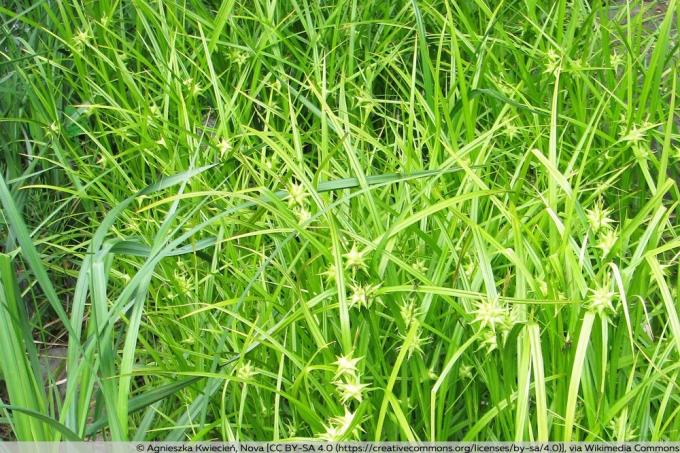
Self-reproduction
The simplest form of propagation is self-sowing, but you cannot control it. Therefore, you should do this if necessary. Remove unwanted propagation as soon as it sprouts or harvest the half-ripe fruits. You do not have to dispose of these immediately, as they are ideal as decoration.
Since the Morgenstern sedge grows clumpy, i.e. it does not belong to the rhizome-forming grasses, the plant does not develop runners. Therefore there is no uncontrolled increase to be feared in this regard.
Controlled propagation
You can multiply Morgenstern sedges by dividing or sowing them.
division
A division of the plant is not only for the purpose of reproduction, but can also help if the morning star sedge becomes bald in the middle. To divide the plant, follow the instructions below:
- Dig up the sedge with a digging fork
- Divide the rhizome with a hatchet or spade
- Minimum size: fist-sized pieces
Ideally, the plant is divided in spring, then you can immediately put the individual pieces in their new location in the soil. If the division takes place between July and October, first put the pieces in pots so that they can overwinter frost-free. They can then be planted in the following spring.
sowing
The morning star sedge is one of the so-called cold germs, i.e. it only germinates when the seeds are exposed to frost or cold. Therefore, late autumn or early winter is the ideal time to sow the sedge. For the bucket culture, it is recommended to sow the seeds in a special planter and to simulate the effects of cold in the refrigerator. Regardless of this, the seed must be regularly supplied with water so that it does not dry out.
Diseases and pests
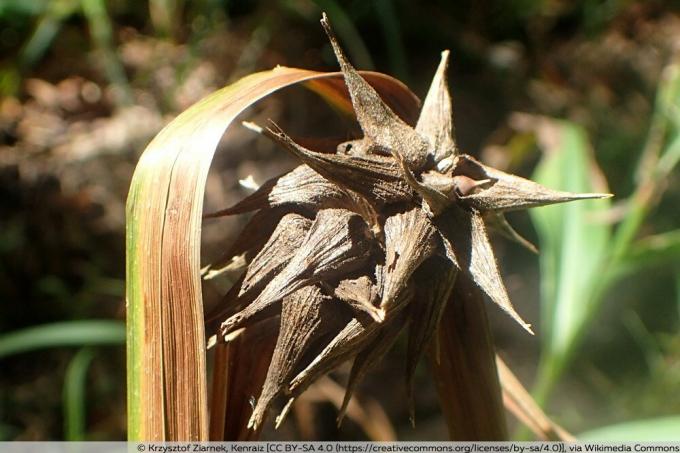
Since Carex grayi is very resilient, diseases are quite rare if the location and care are right. For example, if it is too narrow, rust and mold can attack the plants. As weeds weaken the plants, you should remove them regularly because weakened plants are more susceptible to disease. The morning star sedge is not on the menu of snails.



